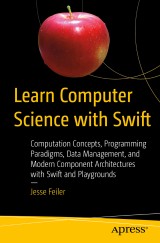Details

Learn Computer Science with Swift
Computation Concepts, Programming Paradigms, Data Management, and Modern Component Architectures with Swift and Playgrounds|
28,88 € |
|
| Verlag: | Apress |
| Format: | |
| Veröffentl.: | 15.12.2017 |
| ISBN/EAN: | 9781484230664 |
| Sprache: | englisch |
Dieses eBook enthält ein Wasserzeichen.
Beschreibungen
<p>Master the basics of solving logic puzzles, and creating algorithms using Swift on Apple platforms. This book is based on the curriculum currently being used in common computer classes. You’ll learn to automate algorithmic processes that scale using Swift in the context of iOS, macOS, tvOS, and watchOS.</p><p>Begin by understanding how to think computationally: to formulate a computational problem and recognize patterns and ways to validate it. Then jump ahead past the abstractions and conceptual work into using code snippets to build frameworks and write code using Xcode and Swift. Once you have frameworks in place, you’ll learn to use algorithms and structure data. Finally, you’ll see how to bring people into what you’ve built through a useable UI and how UI and code relate.</p><p><b>What You'll Learn</b><br></p><ul><li>Recognize patterns and use abstractions<br></li><li>Build code into reusable frameworks<br></li><li>Manage code and share version control</li><li>Solve logic puzzles</li></ul><p></p><div><b>Who This Book Is For</b><div> </div><p></p><p>Young professionals interested in learning computer science from an Apple platform standpoint.</p><p></p></div>
<p><b><i>Learn Computer Science with Swift,</i></b> Jesse Feiler<br></p><p>1. Thinking Computationally </p><p>2. Writing Code and Using Swift Playgrounds</p><p>3. Exploring Programming Paradigms</p><p>4. Using Algorithms</p><p></p><p>5. Managing Control Flow: Repetition</p><p></p><p>6. Working with Data - Collections</p><p>7. Working with Data - Types</p><p></p><p>8. Managing Control Flow: Beyond Repetitions</p><p></p><p>9. Storing data and Sharing Data</p><p>10. Building Components</p><p>11. Using Events to Guide Actions</p><p>12. Getting into Xcode in depth</p><p>13. Bringing in People</p>14. Graphics and Visualization Techniques and Problems<p></p><p></p><p></p>
<b>Jesse Feiler</b> is a developer, consultant, and author specializing in database technologies and location-based apps. He is the creator of Minutes Machine the meeting management app, as well as Saranac River Trail app a guide to the Trail that includes location-based updates as well as social media tools. His apps are available in the App Store and are published by Champlain Arts Corp (champlainarts.com). Jesse is heard regularly on WAMC Public Radio for the Northeast's The Roundtable. founder of Friends of Saranac River Trail, Inc. A native of Washington DC, he has lived in New York City and currently lives in Plattsburgh NY.
<p>Master the basics of solving logic puzzles, and creating algorithms using Swift on Apple platforms. This book is based on the curriculum currently being used in common computer classes. You’ll learn to automate algorithmic processes that scale using Swift in the context of iOS, macOS, tvOS, and watchOS.</p><p>Begin by understanding how to think computationally: to formulate a computational problem and recognize patterns and ways to validate it. Then jump ahead past the abstractions and conceptual work into using code snippets to build frameworks and write code using Xcode and Swift. Once you have frameworks in place, you’ll learn to use algorithms and structure data. Finally, you’ll see how to bring people into what you’ve built through a useable UI and how UI and code relate.</p>
<p>Think computationally to use Swift to solve logic puzzles and create algorithms</p><p>Collect lines of code into blocks, functions, procedures, and methods</p><p>Structure data with Swift</p>
<p>Think computationally to use Swift to solve logic puzzles and create algorithms</p><p>Collect lines of code into blocks, functions, procedures, and methods</p> <p>Structure data with Swift<br></p> <ul> </ul>
Diese Produkte könnten Sie auch interessieren:

Automatización Eficiente. Transformando la gestión de datos por medio de Microsoft Access

von: Damir-Nester Saedeq

13,99 €















